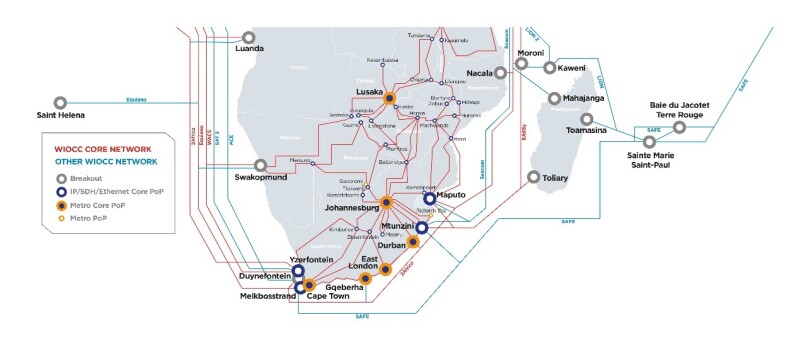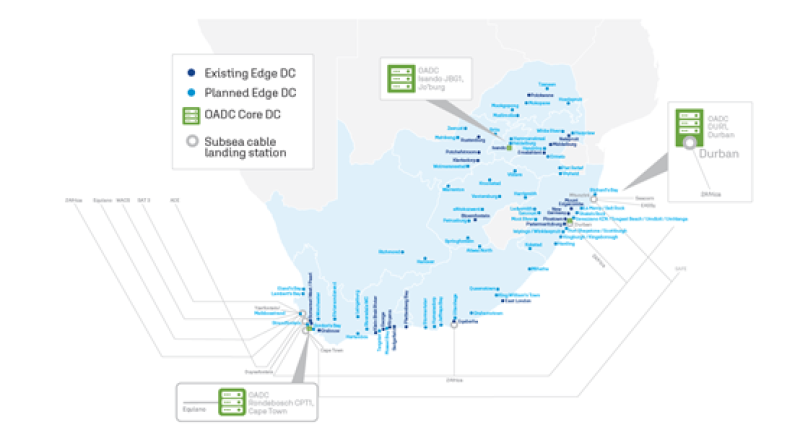Chris Wood, Group CEO of WIOCC, talks about how the company has been a key catalyst for internet growth in Africa in recent years.
Africa’s digital transformation is well underway. Its internet economy is becoming more established, addressing a population of almost 1.4 billion, which includes more than 500 million internet users and over 330 million eCommerce consumers[1]. Adoption of social media and content services including Facebook, Netflix, YouTube and Google is exploding, with more than 247 million Facebook subscribers in Africa at December 2021[2], up from 170 million in 2017 and just 50 million in 2013. Businesses are migrating to cloud-based solutions and outsourcing key functions to third parties while continuing to support large numbers of home workers.
Connectivity is fundamental to this; specifically the deployment of converged, open digital infrastructure. Taking advantage of the opportunities presented by digital transformation requires a reliable and extremely scalable open-access digital backbone with the capacity, reach and resilience to deliver its benefits throughout Africa.
Throughout the last 15 years WIOCC has been a key catalyst for internet growth in Africa, investing over $500m in creating open access, hyperscale digital infrastructure for Africa. It has achieved this through strategic investment in key subsea and terrestrial systems enabling delivery of end-to-end managed wholesale connectivity services to cloud operators, content providers, telcos and internet service providers. This connectivity underpins their Africa networks, enabling them to optimise costs and customer experience. Looking ahead, WIOCC will invest a further $500m over the next 5-10 years in extending this infrastructure across Africa.
International capacity - a digital transformation imperative
Wholesale international capacity demands have grown in recent years, from a few tens of Megabits per second (Mbps) per circuit to multi-100 Gigabits per second (Gbps) - on multiple routes for resilience. This is driven by African consumers’ needs to reach cloud-based content overseas, and the global cloud community migrating content into Africa to optimise end-user experience.
As a result, new high-capacity subsea cable systems are in deployment around Africa. WIOCC is a fibre pair investor in two new hyperscale subsea cables for Africa: Equiano, scheduled to be operational by end-2022, and 2Africa which will go live by end-2023/4. Each system will add more than 100 Terabits per second (Tbps) of capacity to Africa’s international capacity inventory.

These new systems also improve reliability through new routes and new landings. Importantly, both cable systems are based on open-access principles, landing in open-access data centres to ensure fair competition in extending connectivity into Africa.
Equiano |
The 144Tbps, 12,000+km Equiano cable runs from Portugal along Africa’s western seaboard to South Africa. WIOCC is a fibre pair owner in the system and lands the cable directly into WIOCC Group company Open Access Data Centre’s (OADC) flagship carrier-neutral data centre (DC) in Lagos, Nigeria, and extends it into the new OADC Rondebosch facility in Cape Town. |
2Africa |
The 45,000+km 2Africa cable will be the longest subsea cable system in the world. It has a design capacity of 180Tbps and will interconnect 33 countries in Africa, the Middle East and Europe. WIOCC is a fibre pair owner and is landing the cable directly into OADC’s Durban DC. |
Bridging connectivity gaps – inland extension
WIOCC’s position as a Landing Partner for both cables is crucial in making this international connectivity available beyond the landing stations, via national, metro and local networks. It is a leading wholesale connectivity player in many countries, operating national and metro fibre networks to support local operators in delivering the reliable, high-speed connectivity demanded by end-users. In South Africa it operates a hyperscale national backbone connecting all key business hubs, with metro network coverage across all major cities. It is deploying a national fibre network across Nigeria, with over 70 Points of Presence (PoPs), and extending metro coverage. It also offers clients multiple-path, redundant routes from the coast into landlocked countries such as Uganda, Zimbabwe, Botswana, Zambia and Malawi.
Extending cloud to the edge – the missing piece
In Africa, DC deployment has focused on the largest cities, resulting in islands of high-quality cloud connectivity. OADC is democratising the African cloud, extending the cloud ecosystem from these urban hubs via its nationwide network of open access ‘midi’ and edge DCs. With core DCs in Cape Town, Durban and Johannesburg and 30 edge DCs across South Africa, this unique core-to-edge architecture is assisting fixed and mobile operators in extending networks cost-effectively, helping the cloud community migrate content closer to the network edge, supporting outsourced disaster recovery and underpinning rollout of new revenue-generating services. Open access, hyperscale inter-connectivity between each DC, via WIOCC’s extensive wholesale infrastructure or any other carrier network, supports multi-directional data exchange and completes the picture of a converged, open digital infrastructure for South Africa.

In Lagos, OADC is constructing a world-class, Tier III data centre on the largest DC campus in West Africa – a facility that is the future digital hub for Lagos and West Africa (operational from November 2022). Phases #2 and #3 will complete coverage of South Africa and extend the model to other African markets, starting with Nigeria.
[1] Statista
[2] Statista





